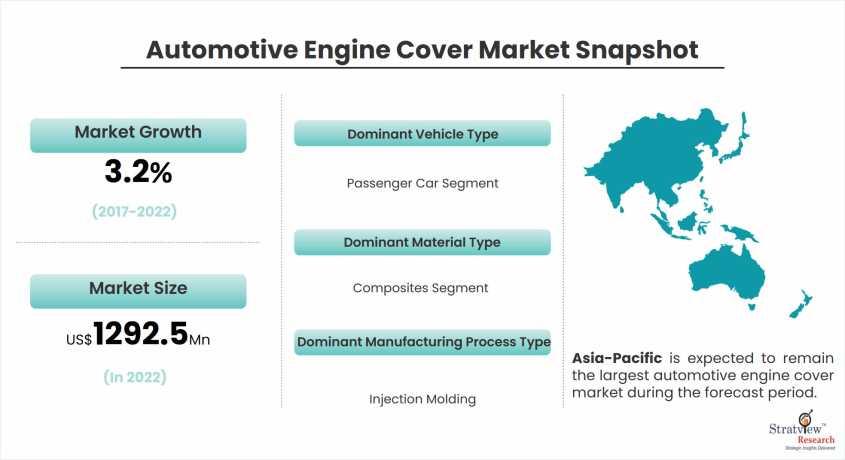For years, the engine cover resided in the shadows of a car's hood, often perceived as a purely cosmetic embellishment. However, a significant shift is underway. The automotive engine cover market is experiencing a surge in demand, transitioning from a niche segment to a near-essential component. This report explores the factors driving this rising demand, highlighting the evolving role of engine covers in the modern automobile.
Market Overview and Current Landscape
As per Stratview Research, the global automotive engine cover market size was valued at USD 1077.7 million in 2016 and it is expected to reach USD 1292.5 million in 2022, growing at a CAGR of 3.2% during the forecast period of 2016-2022. This growth indicates a rising demand for engine covers, suggesting a market with promising potential.
Beyond Aesthetics: Unveiling the Functional Value
Traditionally, engine covers were viewed primarily as aesthetic enhancements, adding a touch of style to the engine bay. However, their true value lies in the functionality they offer. Engine covers act as the engine's first line of defense, shielding it from a barrage of external threats:
- Debris and Dust: Roads are a battleground for debris like rocks, leaves, and twigs. Engine covers prevent these elements from entering the engine compartment, potentially causing damage to delicate components.
- Moisture Ingress: Water and moisture can wreak havoc on an engine's electrical system and internal components. Engine covers create a barrier, minimizing the risk of moisture-related issues.
- Heat Insulation: Modern engines generate significant heat. While some engine covers are designed to allow for proper ventilation, they can also contribute to a slight reduction in engine compartment temperatures.
These protective capabilities translate into several benefits for car owners:
- Reduced Maintenance Costs: By preventing debris and moisture ingress, engine covers can help extend the lifespan of various engine components, potentially reducing maintenance costs over time.
- Improved Engine Performance: Maintaining a clean and protected engine environment can contribute to smoother engine operation and potentially improve overall performance.
- Enhanced Engine Life: Shielding the engine from harsh external elements can contribute to its longevity.
Fueling the Demand: Key Drivers of Growth
Several key trends are propelling the increasing demand for automotive engine covers:
- Focus on Fuel Efficiency: Manufacturers are laser-focused on improving fuel economy in vehicles. Engine covers, particularly those crafted from lightweight materials like composites, play a role in achieving this goal by contributing to overall vehicle weight reduction.
- Lightweighting Trend: The automotive industry is witnessing a global shift towards lightweight vehicles. Engine covers made from composite materials perfectly align with this trend, offering weight reduction without sacrificing functionality.
- Rising Passenger Car Ownership: The growing popularity of passenger cars, particularly in emerging economies, is another factor driving the demand for engine covers. As car ownership continues to rise globally, so too will the need for replacement and new engine covers.
- Growing Aftermarket Awareness: Consumers are becoming increasingly aware of the functional benefits offered by engine covers. This growing awareness is leading to a rise in demand within the aftermarket segment.
Market Segmentation: Catering to Diverse Needs
The increasing demand for engine covers translates to a diverse market catering to various needs:
- Material Options: The market offers a range of materials, each with its own advantages. Composites are a popular choice due to their lightweight properties, while metals like aluminum provide superior durability. For a balance of both, some manufacturers offer hybrid options that combine different materials.
- Vehicle Specificity: Engine covers are not one-size-fits-all. Manufacturers offer covers designed specifically for different makes and models of vehicles, ensuring a proper fit and optimal functionality.
- Performance Levels: From basic protection to high-performance options designed for racing applications, the engine cover market caters to a spectrum of needs. Performance covers often utilize advanced materials like carbon fiber for maximum weight reduction and heat resistance.
Challenges and Opportunities: Navigating the Road Ahead
While the demand for engine covers is on the rise, some challenges need to be addressed:
- Cost Factor: Replacement engine covers can be expensive, potentially discouraging some consumers from routine maintenance or upgrades. Manufacturers can address this by offering a wider range of price points.
- Aftermarket Education: Many car owners still lack awareness about the importance of engine covers. Educational initiatives can help bridge this knowledge gap and encourage wider adoption in the aftermarket.
- Customization Options: While the market offers a variety of options, some car enthusiasts may crave more customization possibilities. Manufacturers can explore offering custom designs or color options to cater to this segment.
The Future of Engine Covers: Innovation and Sustainability
As the demand for engine covers continues to grow, innovation and sustainability will be key driving forces:
- Advanced Material Development: Research and development of even lighter and more durable materials with superior heat resistance will continue to push the boundaries of engine cover performance.
- Integration with Engine Design: Closer collaboration between engine cover manufacturers and automakers can lead to integrated designs that seamlessly complement the engine's overall architecture and optimize performance.
